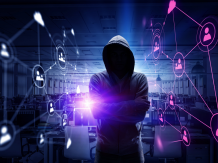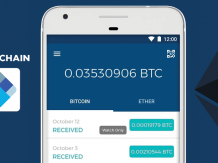Your phones camera could help self-driving cars navigate
Im an associate editor atMIT Technology Review, focusing on the world of cryptocurrencies and blockchains. My reporting, which includes a twice-weekly, blockchain-focused email newsletter, Chain LetterMore(subscribe here), revolves around one central question: Why does blockchain technology matter?
To unleash the potential of blockchain in the energy sector, Jesse Morriss team at RMI has joined with Austria-based blockchain startupGrid Singularityto create a new nonprofit called theEnergy Web Foundation. Earlier this month, the EWF launched its own blockchain, which Morris says is purpose-built for the energy sector. Based on Ethereum, the network will be a test bed for promising use cases. To validate transactions during the test, EWF will rely on 10 major energy companies that have signed on as affiliates.
Not an Insider? Subscribe now for unlimited access to online articles.
HoloLens can now guide the blind through complicated buildings
Log infor two more free articles, orsubscribe now
The team will begin with applications like tracking renewable-energy certificates. In the longer term, though, Morris envisions a world in which homes and buildings are equipped with software that automatically sells and buys power to and from the grid on the basis of real-time price signals.
Richard RamchurnsThe Momentlets you play film director, using just your brainwaves.
GDPR is finally here, and its already chaos
Problem is, the way we manage these certificates sucks, and its holding up investment in renewable power, says Jesse Morris, an energy expert at theRocky Mountain Institute. A new system based on blockchain, the technology at the heart of Bitcoin and other digital currencies, could fix this, he says.
When a renewable-power plant generates a unit of electricity today, a meter spits out data that gets logged in a spreadsheet. The spreadsheet is then sent to a registry provider, where the data gets entered into a new system and a certificate is created. A second set of intermediaries brokers deals between buyers and sellers of these certificates, and yet another party verifies the certificates after they are purchased.
FDA halts one of the first human CRISPR studies before it begins
Revert to MIT Enterprise Forum pricing
How Blockchain Could Give Us a Smarter Energy Grid
Six issues of our award winning print magazine, unlimited online access plus The Download with the top tech stories delivered daily to your inbox.
But the traditional system hasnt yet figured out how to deal with this kind of local trading, Green says. How much should you pay for using a discrete part of the network? She says her companys platformand blockchain technology in generalcan add a level of sophistication to the market by enabling those more granular transactions.
Log infor more, orsubscribe nowfor unlimited online access.
Im not kicking our smart speaker out of the house just yet, but the consequences of having it in my familys life are becoming clear.
Subscribe nowfor unlimited online access.
Energy experts believe that blockchain technology can solve a maze of red tape and data management problems.
Presented in partnership withQualcomm
Visitors are allowed 3 free articles per month (without a subscription), and private browsing prevents us from counting how many stories youve read. We hope you understand, and considersubscribingfor unlimited online access.
The mission of MIT Technology Review is to equip its audiences with the intelligence to understand a world shaped by technology.
! insider.display.menuOptionsLabel !
Your phones camera could help self-driving cars navigate
Please read ourcommenting guidelines.
Yes, Alexa is recording mundane details of your life, and its creepy as hell
Unlimited online access including all articles, multimedia, and more
10% Discount to MIT Technology Review events and MIT Press
We noticed youre browsing in private or incognito mode.
Oculus just kicked off an experiment in social VR
MIT Technology Review © 2018v.ei
Unlimited online access including articles and video, plus The Download with the top tech stories delivered daily to your inbox.
By signing up you agree to receive email newsletters and notifications from MIT Technology Review. You can unsubscribe at any time. View ourPrivacy Policyfor more details.
And thats just the beginningmany energy experts are convinced that blockchain technology has the potential to touch off a fundamental transformation of modern energy grids.
! insider.display.menuOptionsLabel !
of three free articles this month.Subscribe nowfor unlimited online access.
Unlimited online access including all articles, multimedia, and more
This is your last free article this month.
Technology Review PDF magazine archive, including articles, images, and covers dating back to 1899
Bitcoincybersecuritysecurityblockchainelectricity gridrenewable electricityrooftop solar panelsrocky mountain institutepowerEmTech MIT 2017MIT Technology Review EventsEmTech Digital 2018
Yes, Alexa is recording mundane details of your life, and its creepy as hell
What it means to be constantly connected with each other and vast sources of information.
GDPR is finally here, and its already chaos
Youve read all your free articles this month.
Print + Digital Magazine (6 bi-monthly issues)
On an electricity grid, electrons generated from the sun, wind, or other renewable sources are indistinguishable from those generated by fossil fuels. To keep track of how much clean energy is produced, governments around the world have created systems based on tradable certificates.
The headsets ability to map a space and talk people through it may prove more important than the mixing-imagery-with-reality stuff.
Print Magazine (6 bi-monthly issues)
The Downloadnewsletter with top tech stories delivered daily to your inbox
Subscribe nowfor unlimited online access.
Tezos tokens are akin to Amazon AWS credits
FDA halts one of the first human CRISPR studies before it begins
Oculus just kicked off an experiment in social VR
In such a system, neighbors could simply trade energy with one anothera far more efficient process than selling electrons back to the grid first. Power Ledger has demonstrated a product that can turn an apartment building into a microgrid based on a shared system of solar panels and battery storage, for example. Another company, called LO3 Energy,set up a neighborhood microgrid in Brooklyn.
By signing up you agree to receive email newsletters and notifications from MIT Technology Review. You can unsubscribe at any time. View ourPrivacy Policyfor more details.
Everything included in Insider Basic, plus the digital magazine, extensive archive, ad-free web experience, and discounts to partner offerings and MIT Technology Review events.
The electricity sector is, for the most part, still based on massive, centralized power plants that generate power sent long distances over transmission and distribution lines. In recent years, though, a growing number of smaller distributed power generators and storage systems, like rooftop solar panels and electric-vehicle batteries, have been connecting to the grid.
The Downloadnewsletter with top tech stories delivered daily to your inbox
What if the meter wrote the data directly to a blockchain instead? Most of these problems would vanish at a stroke, says Morris.
Subscribe nowfor unlimited online access.
The Downloadnewsletter with top tech stories delivered daily to your inbox
To continue reading this article, please exit incognito mode orlog in.
The owners of these systems struggle to maximize their value because the system is so inefficient, says Jemma Green, cofounder and chair of Power Ledger, an Australia-based startup developing a blockchain-based platform that allows producers to trade energy peer-to-peer with consumers. For instance, it generally takes 60 to 80 days for an electricity producer to get paid. With a blockchain-based system, Green says, producers can get paid immediately, so they need less capital to start and run a generating business.
Meet the Experts in AI, Robotics and the Economy at EmTech Next.
Unlimited online access including all articles, multimedia, and more
A blockchain is a shared, encrypted ledger that is maintained by a network of computers. These computers verify transactionsin the case of Bitcoin, the transfer of cryptocurrency between individual users. Each user can access the ledger, and there is no single authority (see Why Bitcoin Could Be Much More Than a Currency). Advocates say the technology could be especially promising in industries where networks of peerselectricity producers and consumers, connected via the grid, for instancedepend on shared sets of data.
Such a byzantine system racks up transaction costs, while leaving plenty of room for accounting errors that can range from honest mistakes to outright fraud. The lack of transparency also scares many people off entirely.
Keeping track of renewable-energy certificates is one of dozens of potential applications of blockchain technology that could solve data management challenges in the electricity sector without disrupting business as usual, according to Morris. He and many others believe that in the long term, the technology could help transform the very architecture of the grid itself.



